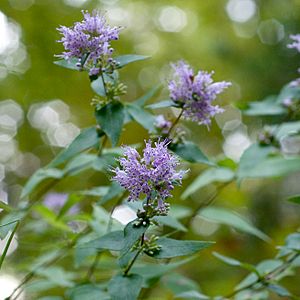Cunila origanoides facts for kids
Quick facts for kids Cunila origanoides |
|
|---|---|
 |
|
| Scientific classification | |
| Genus: |
Cunila
|
| Species: |
origanoides
|
Cunila origanoides, also known as stone mint, frost mint, dittany, or American dittany, is a special plant native to the Eastern United States. It is a perennial plant, meaning it lives for more than two years, and it flowers in late summer. This plant is a subshrub, which means it's a small, woody plant that doesn't grow very tall. It has small, pretty purple flowers.
Stone mint likes to grow in dry forests and in thin soil around rocky areas. For a long time, people have grown this plant because it can be used as a medicinal herb, to make tea, or simply as a beautiful ornamental plant in gardens.
Contents
What is Stone Mint?
Stone mint is a unique plant that belongs to the mint family, Lamiaceae. Its scientific name, Cunila origanoides, helps scientists around the world know exactly which plant they are talking about. The plant gets its common names like "stone mint" and "frost mint" from where it often grows and how it looks.
Appearance of the Plant
This plant is usually small, growing only about 1 to 2 feet (30 to 60 centimeters) tall. It has many thin, woody stems that branch out. The leaves are small, oval-shaped, and have tiny teeth along their edges. They grow in pairs along the stem. When you crush the leaves, they often have a strong, minty smell.
Flowers and Seeds
The flowers of stone mint are tiny and usually a light purple or pinkish color. They grow in clusters at the ends of the stems. These small flowers attract many pollinators, like bees and butterflies, which help the plant make seeds. After the flowers bloom, small, dry fruits form, each holding a few tiny seeds.
Where Does Stone Mint Live?
Stone mint is found naturally in the eastern parts of the United States. It grows from New York south to Florida and west to states like Missouri and Oklahoma.
Favorite Places to Grow
This plant prefers sunny or partly shady spots. It especially likes dry, rocky soils that don't hold a lot of water. You can often find it growing on hillsides, in open woodlands, or in the thin soil that collects in cracks and crevices of rock outcrops. These are places where many other plants might struggle to grow.
How It Spreads
Stone mint can spread in a few ways. Its seeds can be carried by wind or small animals to new locations. The plant can also spread slowly through its roots, forming small clumps over time. This helps it establish itself in its preferred rocky habitats.
How People Have Used Stone Mint
For hundreds of years, people have valued stone mint for its various uses. It has been an important plant for different cultures, especially for its traditional medicinal properties and as a flavorful ingredient.
Traditional Medicine and Tea
Native American tribes and early European settlers used stone mint for its health benefits. They would often make a tea from the leaves and stems. This tea was traditionally used to help with colds, fevers, and stomach problems. It was also sometimes used to help people sweat, which was believed to help with illness.
Stone Mint in Gardens
Besides its medicinal uses, stone mint is also grown as an ornamental plant. Its small purple flowers and pleasant scent make it a nice addition to gardens. It's especially good for rock gardens or areas with dry soil, as it doesn't need much water once it's established. Some people also grow it for its leaves, which can be used to make a refreshing herbal tea.
Images for kids


